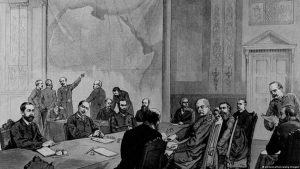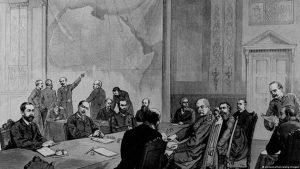Borderlands and Bloodbaths: The case of Congo and Ukraine
 15 Desember 2022
15 Desember 2022

By Jan Lundius
STOCKHOLM, Sweden, Dec 15 2022 (IPS)
During November, soldiers of the March 23 Movement (M23) have been approaching Goma in the eastern territory of the Democratic Republic of the Congo (DRC), close to the Rwandan border. About 180.000 people are now leaving Goma, a city with a million inhabitants. Many stakeholders are involved in the conflict and there is an apparent danger that the overall carnage that affected the Congolese eastern border areas fifteen years ago will resume. At the same time, war is ranging in Ukraine, which name likely comes from the old Slavic term for borderland.
Disputed border areas have often been hotbeds for horrific and widespread wars. World War I began with border conflicts between the Austro-Hungarian Empire and Serbia, while World War II was ignited through German allegations of Czech and Polish mistreatment of Germans living on their side of the border. Tensions are constantly brewing along borders between India and Pakistan, Israel and Palestine, Ethiopia and Sudan, Armenia and Azerbaijan – just to mention a few border conflicts present all over the world.
Throughout history, borderlands have suffered from looting, massacres and ethnic violence, generally triggered off by incursions from neighbouring countries, causing chaos and destruction. Borderlands are generally speaking a result of clearly defined borders between European nations, established after the Westphalian Peace Agreements in 1648, ending the Thirty Years’ War, a conflagration between religious factions that devastated Germany, killing 30 per cent of its population.
Before mid-17th century, European borders were quite diffuse. A royal realm had its heartland, a centre from which it could expand through wars, treaties and negotiations. In medieval Europe the more or less undefined areas between different sovereignties were called marks, or marches, words deriving from an Indo-European term meaning edge. A mark/march often served as a buffer zone, more or less independently governed by a marquis/margrave.
As a result of the Westphalian Peace, national borders became demarcated by border markings and lines drawn upon maps. Such boundaries were eventually introduced to the rest of the world. In Africa, border demarcations became common after the Berlin Conference, 1884-1885, when leaders of fourteen European nations and the United States agreed upon a “partitioning” of Africa, establishing rules for amicably dividing resources among Western nations. Notably missing was any representative from Africa.
One of the proclaimed aims of the Berlin Conference was to bring “civilization” to Africa, in the form of free trade and Christianity. Accordingly could King Leopold II of Belgium, by playing the part of a beneficent monarch, succeed in convincing his counterparts that he would personally bring order, faith and prosperity to the heart of Africa. Congo was thus formally recognized as Leopold’s personal possession. An extraordinarily rich territory, with ivory, minerals, palm oil, timber and rubber, was used by Leopold to increase his personal wealth. Missionary stations and trade routes were established, while slave labour extracted the natural resources. If production targets were not met, the autochthonous population risked severe punishment, ranging from having their families held hostage in concentration camps, to torture, the severing of a hand, and eventual execution.
Between 1900 and 1930, European colonial powers completed cartographic surveys of African territories. However, surveys focused solely on land control while disregarding the impact recently established borders might have on the well-being of the original population. Local communities suffered limitations to their daily activities and nomadic practices. Traditional life, administrative structures, and economic safety were negatively affected. Furthermore, colonial rule tended to instigate conflicts. Imposed borders gradually set off hostile relations among borderland dwellers and eventually enabled post-independent governments and political elites to use such divisions for political means.
The sheer size of the territory, which eventually became the Democratic Republic of Congo (DRC), made its governance extremely challenging. This vast nation is about the same size as Western Europe and has 10,500 kilometres of external borders. In the middle of the country is an almost impenetrable and vast jungle area. Border control is largely non-existent, providing neighbouring countries with an opportunity to exert influence into remote peripheries. For many Congolese, it is easier to reach the capital of a neighbouring state than travelling to the capital city, Kinshasa.
As in other areas of the world, people on both sides of Congolese borders exchange goods, spouses, languages and customs. Nevertheless, in spite of all this mixture and exchange, most people living along borders generally continue to be aware of their roots in different cultural settings. Even if they might share a lingua franca, several of them tend to maintain their original language and specific customs. Border communities thus find themselves in a precarious balance, which might be upheld for centuries but also runs the risk of becoming swiftly overturned by armed attacks from national armies, warlords, or hordes of bandits and uprooted former soldiers, as well as massive influxes of refugees.
During the so called First– and Second Congo Wars, and their aftermath, approximately 5.4 million died between 1994 and 2008, deaths mainly caused by disease and malnutrition, though massacres committed by all the warring factions also killed staggering numbers of civilians. Nine African nations and around twenty-five armed groups were involved in the wars. The mayhem began in April 1994, when about 1.5 million Rwandans settled in eastern DRC. These refugees included Tutsis fleeing Hutu mass murderers, and eventually one million Hutus fleeing the Rwandan Patriotic Front’s (RPF) subsequent retaliations.
The shooting down of a plane carrying Rwandan President Juevénal Habyarimana, a Hutu, served as catalyst for a genocide lasting for approximately 100 days. Between 500,000 and 1 million Tutsis and politically moderate Hutus were in Rwanda killed during well-planned attacks, ordered by an interim government. This genocide ended when the Tutsi commanded Rwandan Patriotic Front (RPF) gained control and took over the Rwandan Government, making approximately two million Hutus fleeing across the border into neighbouring Zaire. Estimates of the number of Hutu civilians killed in subsequent revenge massacres by the RPF range from 25,000 to 100,000.
Rwandan incursions into Zaire occurred after years of Congolese internal strife, dictatorship and economic decline. Zaire, as the country was called at the time, was in 1994 a dying State. In many areas, increasingly corrupt state authorities had in all but name collapsed, with infighting militias, warlords, and rebel groups wielding local power.
International response to the Rwandan genocide had been lame and limited, though this time international opinion reacted immediately. Massive relief support was directed to refugees in eastern Zaire. In the meantime, several, heavily armed Rwandan gėnocidaires, genocide perpetrators, organized themselves among Hutu refugees. In their attacks on Banyamulenge, a Tutsi minority who for centuries had been living in Congo, the gėnocidaires were often joined by local militia. Banyamulenge were resented by several Congolese agriculturists, who suspected them of planning to take over their land.
Currently it is the rebel group M23, which is the main aggressor. The rebel group was in 2012, according the UN, created and commanded by the Rwandan army. The Rwandan Government did in 2013 officially cease its support to M23; its members surrendered and were transferred to a refugee camp in Uganda. However, M23 reappeared in 2017, evidently with renewed Rwandan support. The Congolese mayhem is just one example of what might happen in border areas when control and peaceful interaction between neighbours collapse under the pressure of foreign interventions and enter a bloody, anarchic chaos.
Like in central Africa, Ukraine border conflicts have at several occasions triggered massacres and bloody chaos. For more than 500 years, Ukraine was divided and ruled by a variety of external powers, including the Polish-Lithuanian Commonwealth, the Austro-Hungarian Empire, the Ottoman Empire, the Cossack Hetmanate, Poland, the Tsardom of Russia, the Soviet Union and Nazi Germany
From the beginning of the last century to 1921, millions fled Ukraine, including more than 2 million Jews. Ukrainians were killed en masse by Austrians, Poles and warring political factions, while approximately 110,000 Jews were murdered during so called pogroms. Worse was yet to come when Nazi invaders within the same areas murdered approximately 1.7 million Jews. In Nazi-occupied Ukraine, 5.7 million locals died between 1941 and 1945. And now, during Russia’s aggressive invasion, the suffering and slaughter of innocents have been resumed.
The curse of borders, between nations and people, continues to haunt us. To safeguard the future – for our earth and children – we have to learn that general well-being depends on collaboration between nations and peoples, regardless of ethnicity, gender, and ideologies. Wars, like Russia’s ruthless attack on a sovereign nation and the central African mayhem, are crimes against humanity and must be stopped through peaceful solutions. Time is running out and cannot be wasted on armed conquests and bloodshed.
Sources: Stearns, Jason K. (2011) Dancing in the Glory of Monsters: The Collapse of the Congo and the Great War of Africa. New York: PublicAffair and Veidlinger, Jeffrey (2021) In the Midst of Civilized Europe: The Pogroms of 1918-1921 and the Onset of the Holocaust. London: Picador.
IPS UN Bureau
